2 Theory- Based Debriefing Methods of Simulations
Theory- Based Debriefing Methods of Simulations by Raquel Bertiz, PhD, RN, CNE, CHSE
This chapter is written for nurse educators in academic and practice settings with prior knowledge of the basic foundations of simulation-based education (SBE). Basic knowledge of debriefing simulations are a necessary foundation to learning advanced debriefing techniques.
Learning Objectives
•Describe the theory, standards and methods of debriefing/reflective practice.
I. Introduction
Metacognition is ” thinking about thinking”, or more formally, “knowledge and cognition about cognitive phenomena”. It is important for health professionals including nurses to know what they know and do not know, and therefore can focus on acquiring what they do not know. In an ever increasingly complex healthcare environment, nurses who have the ability to be self-regulated or self-directed learners is essential (Medina et al, 2017). Metacognition equates to increased awareness of one’s own thought processes leading to critical thinking and monitoring of actions, thus, sound clinical judgment. Nurse educators need to be purposeful in designing instruction, both in the classroom and clinical settings (simulated and actual patient care) that allow learners to develop metacognition. This is emphasized by Morse et al. (2021) who state “ongoing shifts in the healthcare system require practitioners who possess metacognitive skills to evaluate their decisions and the thinking and rationale guiding those decisions.” The authors go on to claim that nurse educators embraced Simulation-Based Education (SBE) as an effective teaching and learning strategy, case in point, debriefing provided educators with the opportunity to explore and develop those metacognitive skills with the learners.
Debriefing is a virtual step in the process of the simulation learning experience and is one of key features to consider when operationalizing a simulation learning encounter (Morse et al., 2021; Jeffries, 2015). Morse et al. ( 2021) state in their annual review of research in debriefing :
- Theory-based debriefing as an evidence-based contextual teaching-learning strategy facilitates experiential learning and fosters critical thinking and clinical reasoning.
- Simulation, plus structured debriefing improves learning outcomes, such as clinical performance, problem-solving ability, confidence to perform, critical thinking and clinical reasoning.
As nurse educators begin the use of debriefing across the curriculum, it is imperative that this must be supported by theory and empirical evidence. Several studies also report the need to develop competencies of faculty in facilitating debriefing. Nurse educators, therefore, who decide to adopt this instructional strategy need to be competent. This module explores the theoretical and empirical bases of SBE and debriefing, and specific debriefing methodologies that are currently used in debriefing of simulations; such knowledge is needed prior to practicing these techniques in the simulation laboratory and beyond. The theoretical and empirical bases of debriefing are reflected in the INACSL Healthcare Simulation Standards of Best PracticeTM The Debriefing Process.
II. Theoretical Bases:
Morse et al., (2020) describe two theories that predominantly frame the theory-based debriefing models that will be described in detail below:
- Kolb’s Experiential Learning Theory
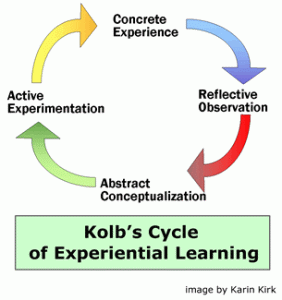
Key Points:
Provides a means to describe the cycle of experiential learning that occurs in SBE, and describes the process by which learners perceive and then transform their experiences in order to create knowledge
Constructs:
a) concrete experience is described as the perception, through the senses of the learning experience; it is dependent on the ability of the learners to involve themselves fully and without bias in new experiences; precedes the reflective period and influences it to the extent that the learners were adequately prepared for the experiences and that the experiences were meaningful to them.
b) reflective observation is the ability to reflect on the experience from many perspectives
c) abstract conceptualization is the ability to create concepts that integrate current observations into logically sound theories
d) Active Experimentation is the ability to use these theories to make decisions and solve problems in similar future situations
- The elements of reflective observation, abstract conceptualization and active experimentation are most directly connected to debriefing as the time to reflect on the event through the participants’ mental model.
- The goal of debriefing is to engage in transformative learning.
2) Mezirow’s Transformational Learning Theory
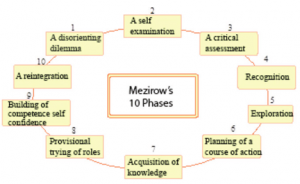
Key Points:
- Transformative learning is learning that transforms problematic frames of reference to make them more inclusive, discriminating, open, reflective and emotionally able to change
- Frames of reference includes habits of mind, cultural biases, ideologies, schemata, stereotyped attitudes and practices, religious doctrine, moral-ethical norms, psychological preferences and schema, paradigms in science and mathematics, frames in linguistics and social sciences, and aesthetic values and standards (Mezirow, 2003)
- Behavior change is a consequence of transformation of the frames of reference
- The transformation occurs through self-reflection by identifying and judging premises, presuppositions, and taken for granted assumptions
- Transformation, or “change” starts with a disorienting dilemma- when usual interpretations and behaviors do not result in success
- Transformed perspective- inclusive, differentiating, permeable, critically reflective and integrative of experience
- The medium of transformation is radical discourse, and lies on these assumptions: discourse meets the conditions necessary to create understanding with another; driven by objectivity; actions and statements are open to question and discussion; understanding is created through the weighing of evidence and by measuring the insight and strength of supporting arguments; primary goal is to promote understanding among others
- Ten phases of transformation (process rather linear) -1) disorienting dilemma ; 2) self-examination with discontent; 3) critically assessing assumptions; 4) recognizing the connection between discontent and the process of transformation; 5) exploring options for new roles, relationships and actions; 6) planning/revising a course of action; 7 ) acquiring knowledge and skills for implementing one’s plan; 8) trying new roles on provisional basis; 9) building competence and self-confidence in new roles and relationships; 10) reintegration of new frame
The structured debriefing methods discussed in this module are supported by the two theories discussed above. Morse et al. (2020, quoting Morse, 2015) asserts that when the debriefing process is a structured, facilitated process that supports transformative learning, it provides an opportunity for the learner to engage in self-reflection and possibly perspective transformation.
Highlight on Prebriefing:
Prebriefing- Debriefing and prebriefing are intertwined, and therefore, the discussion of learning in debriefing starts with prebriefing (Morse et al., 2020). The interaction of the facilitator and the learner is a key dynamic in the learning process in simulation, therefore, it is crucial to establish psychological safety during prebriefing and maintain all throughout the simulation experience. The debriefer needs to conduct prebriefing according to standards of healthcare simulation practice, and INACSL provides the standards: Healthcare Simulation Standards of Best PracticeTM Prebriefing: Preparation and Briefing
Note: An evidence-based prebriefing supports an evidence-based debriefing
II. Theory Based Models of Debriefing
- Debriefing with Good Judgment
The following Key Points are derived from Morse et al. (2020) chapter on Evidence-Based Debriefing, Annual Review of Nursing Research 2020:
- A debriefing method developed by Rudolph et al. (2007) from the Center for Medical Simulation
- Aims to discover the thought processes driving observable actions
- Based on theories from diverse fields such as adult learning theories, behavior change, cognitive psychology and research from organizational research
- The model states that there is no such thing as “nonjudgmental” debriefing and should be done with “good judgment”
- The facilitator uses the “Advocacy/Inquiry” (AI) conversational strategy as a reflective learning technique to uncover the thought process, or cognitive frames, behind the actions observed in simulations
- Through discussion and teaching, the facilitator reinforces positive cognitive frames, or helps to facilitate the creation of new cognitive frames that will support practice moving forward
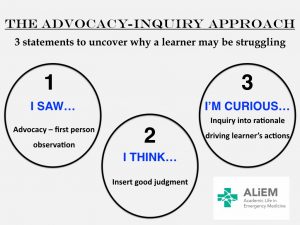
The following video explains the AI method:
This video describes how the facilitator uncovers the learner’s frame:
Exercise: Debriefing with good judgment
Watch the video below and write your observations:
- How did the facilitator use the AI approach?
- If you are the facilitator, how will you apply the AI approach?
Listen to this Podcast by Center for Medical Simulation for tips on how to stay curious:
2. Debriefing for Meaningful Learning (DML)
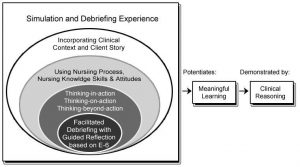
Key Points:
- DML (Dreifuerst, 2012) is a method that uses reflective discourse to uncover relationships between thought processes and nursing actions.
- There are six elements that facilitate thinking process: Engage, Explore, Explain, Elaborate, Evaluate, Extend (Six Es); these elements serve to guide the learners through a reflective learning conversation to facilitate sensemaking of the learning experience and apply current learning to potential future experiences- using “Socratic Questioning”
- Using Socratic Questioning, the debriefer exposed the student’s frame of reference and taken-for-granted assumptions by revealing the relationships between the student’s thinking and actions (Dreifuerst, 2015). See Illustration Below:
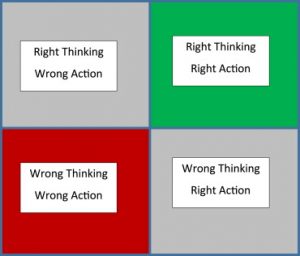
- promotes clinical reasoning by actively promoting reflection-in-action, reflection-on-action, and reflection-beyond-action
- uses a set of worksheets, page 1 is shown below:
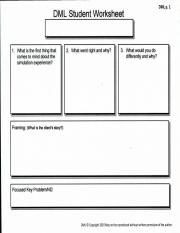
- This article explains how to get started using this technique: Getting Started With Debriefing for Meaningful Learning
3. Promoting Excellence and Reflective Learning in Simulation (PEARLS)
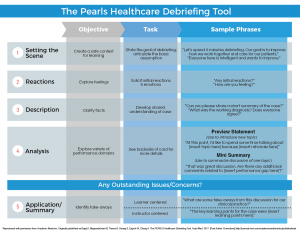
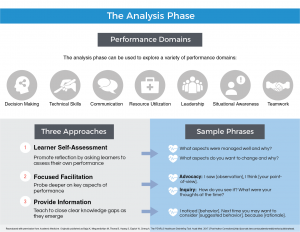
Key Points:
- A method of debriefing described by Eppich and Cheng (2015)
- A blended approach to debriefing that included three educational strategies: learner self-assessment, focused facilitation for reflective learning and providing directive feedback and/or teaching
- This method provides scripting for the debriefer
- This is the site for free download of tools used in PEARLS PEARLS Debriefing Tool
The following video describes the method. More detailed information about this debriefing technique below:
IV. Evaluation of Debriefing
- Debriefing is considered to be where the bulk of learning takes place. Examination of debriefing is needed to help determine if facilitation methods effectively contribute to the learning process (Reed, 2020). There are several instruments that are available in the literature to evaluate debriefing skills of the facilitator, but there are few tools to evaluate participant engagement.
- Instruments to evaluate debriefing include tools to evaluate debriefing skills of novice debriefers by expert debriefers, self-assessment of debriefing, and evaluation of debriefing experience by learners (Morse et al., 2020).
- Regular evaluation and/or appraisal of debriefing are necessary for simulation-based learning. While Debriefing evaluation tools are critical in identifying areas to improve practice and optimize learning the development of debriefing evaluation tools is challenging (Alhaj & Musallam, 2018).
- The Debriefing Assessment for Simulation in Healthcare (DASH)
The DASH is a six-element unweighted, criterion-referenced, behaviorally anchored rating scale that evaluates instructor behaviors that are believed to represent optimal behaviors. It is the most commonly used tool to assess facilitator debriefing skills in prelicensure programs in the United States (Morse et al., 2020). There are three versions of this tool: a) Rater version is designed for trained trainers to rate instructors; b) Student Version- designed for students to rate their instructors and C) Instructor Version- designed for instructors to rate themselves. (Debriefing Assessment for Simulation in Healthcare© (DASH)
See the presentation below on details of the DASH Tool by Kada ( 2021)
DASH TOOL PRESENTATION- MCSRC -Geetha Kada[49425
DASH Tools:
DASH Student Version Short Form
DASH Instructor Version Short Form
2. Debriefing for Meaningful Learning Evaluation Scale (DML-ES)
This instrument was developed specifically for DML debriefers. The need for formal training, assessment of DML competence, and continued development in debriefing has intensified as nursing programs increasingly integrate DML as a teaching-learning method in simulation and across curricula. The demand for a more precise description of DML behaviors to formatively assess debriefing skills led to a process of revising the DMLES and psychometrically testing a new iteration of the instrument. The current version of DML -ES, a revised edition, is a 20-item behavioral rating scale that can be used for both self-assessment (DMLES-Debriefer) and objective assessment (DMLES-Rater) to further understand how well debriefers apply DML (Sheridan et al., 2020).
3. Debriefing Experience Scale (DES)
The DES is a tool with 4 subscales with twenty items where each item is rated by learners on a Likert Scale. The four subscales include:
- Analyzing thoughts and feelings
- Listening and making connections
- Facilitator skill in conducting the debriefing
- appropriate facilitator guidance
Learning Exercise
Watch the prebriefing and debriefing sessions below. If you are the debriefer in this instance, assess yourself using the DASH Instructor Version Short Form.
What are your take aways and lessons that you will apply to your next debriefing?
Prebriefing:
Debriefing:
References:
Bajaj, K., Meguerdichian, M., Thoma, B., Huang, S., Eppich, W., & Cheng, A. (2018). The PEARLShealthcare debriefing tool. Academic Medicine: Journal of the Association of American Medical Colleges, 93(2), 336. https://doi.org/10.1097/ACM.0000000000002035
Cheng, A., Grant, V., Robinson, T., Catena, H., Lachapelle, K., Kim, J., Adler, M., & Eppich, W. (2016). The Promoting Excellence and Reflective Learning in Simulation (PEARLS) Approach to Health Care Debriefing: A Faculty Development Guide. Clinical Simulation in Nursing, 12(10), 419–428. https://doi-org.montgomerycollege.idm.oclc.org/10.1016/j.ecns.2016.05.002
Bradley, C. S., Johnson, B. K., & Dreifuerst, K. T. (2021). Psychometric properties of the revised DML evaluation scale: A new instrument for assessing debriefers. Clinical Simulation in Nursing, 56, 99-107. https://doi.org/10.1016/j.ecns.2021.04.008
